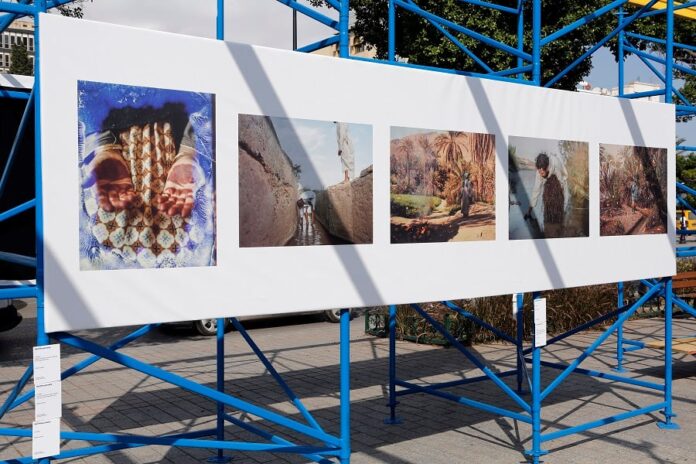TUNIS: Through most of October, Avenue Habib Bourguiba, the central thoroughfare of the Tunisian capital and the point of origin for the country’s 2011 uprising, hosted numerous works of art as part of the sixth edition of the contemporary art festival Jaou Tunis.
According to Tunisian media, the city’s governor has said that Habib Bourguiba “will be designated for cultural, touristic and exhibition activities only.” Art fills the famous street in which protests are now banned.
Following a series of delays due to the COVID-19 pandemic, the biennial festival returned this year as Jaou Photo, an edition dedicated to photography and moving images under the theme “The Endless Body.”
The goal of this year’s edition, says Lina Lazaar, vice president of the Kamel Lazaar Foundation (KLF), which organized the event, “was to decentralize experiencing art to see how one could engage with as many works as possible without being limited to the usual white cube space.”
“Jaou” has many meanings in colloquial Arabic. It most literally translates to “weather” or “atmosphere” and is evocative of happiness — a sense of lightness of being and free-spiritedness. It might seem a contradictory title considering the challenges that Tunisia is facing. But Lazaar believes that art offers a way to examine the urgencies of the moment in a way that offers joy and camaraderie.
Jaou’s central exhibition, “Our Time, Our Dreams,” was curated by Karim Sultan, director of the Barjeel Art Foundation in Sharjah. It housed more than 100 photographs on advertising billboards throughout the city and on scaffolding situated along Avenue Habib Bourguiba.
“In Jaou we wanted to display things in a random, uncalculated way. So we secured Avenue Bourguiba, the landmark avenue on which the Arab Spring was started and where people put their bodies on the line every time there is anything that needs to be challenged in the country,” said Lazaar.
What ensued on the avenue and throughout the city was an exhibition focused on consumerist culture using billboards, he explained, “as a mode of display and a way to communicate with a broader population group.” They repurposed hundreds of billboards and dedicated them to photographs usually only seen in a more-intimate setting “and took on the challenge to entirely rethink the work and (our) engagement with it.”
Despite the ban on protests, towards the end of October, several protests were staged on the avenue with the art from Jaou surrounding them.
The stream of photographs interrupted everyday life in the capital to present visitors and residents with poignant images that focused on the body and its place within nature and the urban landscape, prompting a moment to reflect on some of the world’s most pertinent issues today.
The featured artists included John Akomfrah, Larissa Sansour, Mohammed Zaanoun, Sophia Baraket, Athi-Patra Ruga, Amina Kadous, Amina Menia, Gabrielle Goliath, and Taysir Batniji.
“The body in all its dimensions was the focus — something that is very important during this specific time globally, but more so in Tunisia 10 years after the revolution and the failed hopes that came with it and bodies that haven’t been able to enact and create the change that everyone was hoping for,” said Lazaar. “The edition was as much about individual bodies as it was about collective, social and political bodies and also bodies that wish to be somewhere else, reflective of the theme of migration.”
He added: “We very much tried to stage a form of social experiment. The event engaged a series of photographers and screenplays, involving musicians and choreographers, to try and articulate the narratives of the ‘bodies’ that were displayed publicly, adding a performative dimension to the event.”
Other highlights included pop-up exhibitions, including “A Collective Diary,” curated by Simon Njami, which posed questions about how we live and think together in the modern world. There was also “A Wake Up Song Mr. President,” curated by Andrea Bellini and Lina Lazaar, presenting a selection of highlights from this year’s Biennale de l’Image en Mouvement in Geneva, presenting works by Sophia Al-Maria and Mandy Harris Williams, among others, and staged in the historic Abdellia Palace, which has remained unused since extremists attacked an exhibition in 2012. The exhibition was an attempt to reactivate the space through art.
AT KLF’s B719 Art Station, located in a rural suburb outside of Tunis, there was “Fantasies” by Myriam Boulos, presenting works by a range of curators, artists, and thinkers.
A symposium, directed by Stephanie Baily, titled “What Can We Learn and Unlearn When We Speak Together?” took place at the historic Bourse du Travail and included speakers such as Simon Njami, Karim Sultan, Khookha McQueer, Hito Steyerl and Mouna Karray, among others.
“Middle Eastern art plays a crucial role in capturing the voices of people throughout the region,” Lazaar said.
The KLF was set up by Swiss-Tunisian businessman Kamel Lazaar, who established the investment banking firm Swicorp. Lina, his daughter, now largely runs the show. She has been a major promoter of works by Arab artists over the last 15 years.
In 2015, the KLF hosted a series of talks in the Bardo Museum, which had been the site of a terrorist attack on March 15 that year, when two militants attacked the museum, holding museum visitors hostage. Twenty-two people, predominantly European tourists, were killed.
This year’s Jaou worked with over 165 artists from across the Arab world and North Africa, out of which over 100 worked on the photography exhibition situated on Avenue Bourguiba.
“What was really interesting was how the artists explored what it means to hope collectively today,” Lazaar said. “I think the case of Tunisia resonated as much with American artists as it did with British and Lebanese. There was this disenchantment with institutions and democratic processes and the (effort) that it takes for communities and nations to reorganize and re-elevate themselves.”
As Lazaar stressed, it was the performative aspect of staging such a festival during such a challenging time for Tunisia and the world that gave participants and visitors a renewed sense of “empowerment.”


